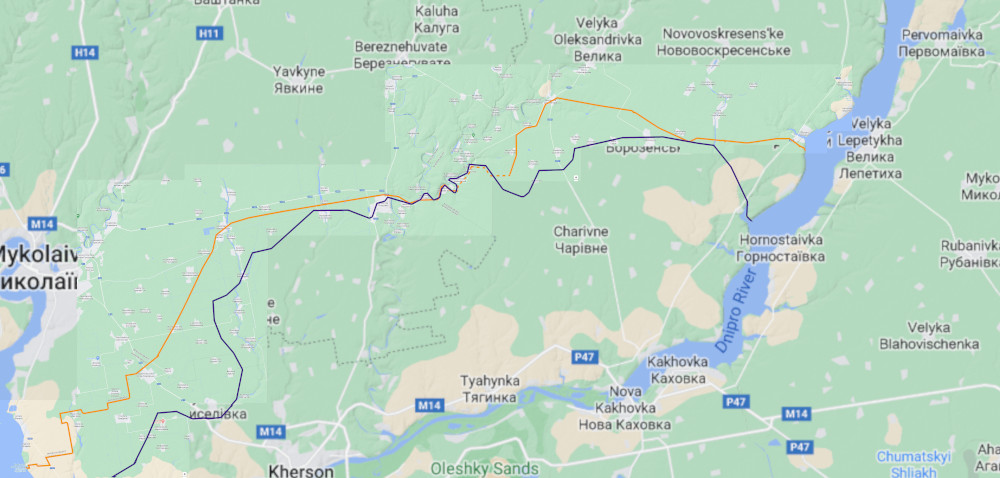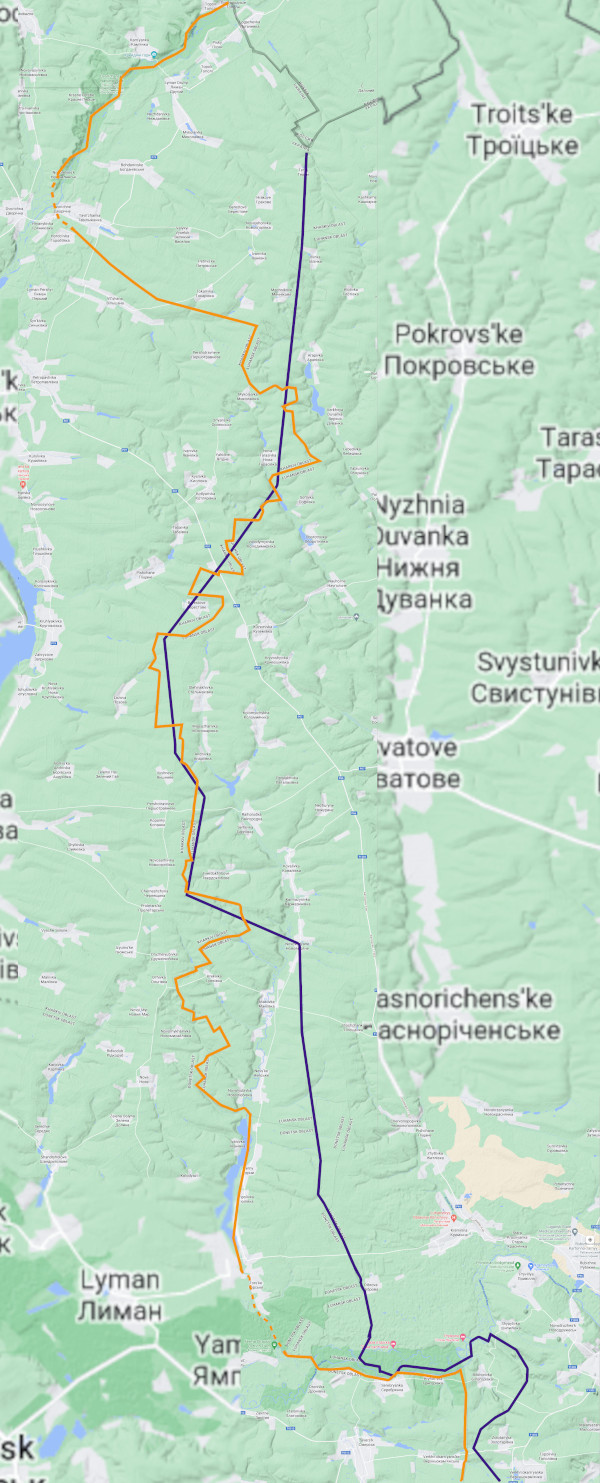Beware Ukrainian maps (and those who swear by them)
This is an exercise rather like the one performed in the previous FBEL article, Some Quietly Stated Surprises Despite General Russian Silence In Special Military Operation.
The point is to notice the disparities between Ukrainian and Russian maps regarding the extent of Russian control.
This time around it’s not a question of trying to understand Russian advance, but the location of the Russian line in the sand (ahead of a new dynamic that will come to exist when 300,000 newly mobilised Russian troops are deployed). It is highly unfashionable to say that there are two parties to how the Ukrainians move on the battlefield in Ukraine and what is now Russian territory, but this site insists that Russia not only has its say in the matter, but also has the major part of it. As things stand at the moment, this translates to where Russia decides is the point where it stops its fighting retreats (still destroying the Ukrainian army in the field as it goes), and where from then onwards the Ukrainians will not pass: the line in the sand.
In the graphic shown above (click to enlarge), the lines are taken from a map produced by liveuamap.com and a map presented in a Russian MoD briefing, both published on 5th October. The orange line is what the Russians appear to claim to be the extent of their control on to the north of the Dnipro river. The blue line is what the Ukrainians claim. A cursory glance shows that Russia has not necessarily withdrawn from Davydov Brod (where the orange line hinges at its northern-most point), and Russian MoD briefings to 5th October give no indication that it has either (monitoring will continue unless or until at some time it is made obvious one way or another).
In Kherson it seems, at the weekend, the Ukrainians might have been trying to solve their stuck-on-the-Ingulets-and-unable-to-capture-Davydov-Brod problem. While attempting yet again, on 30th September, to move out from their bridgehead, a large motorised/mechanised contingent then started on 1st October to race along the road that runs down the western side of the Dnipro. The Russians forced all this activity to cease on 2nd/3rd October, and as far as the mobile element of it was concerned, at a place called Dudchany – which, on the map, is up against the Russian version of the line of contact where there is a river inlet. The Russians had withdrawn – so says the Russian Ministry of Defence – to prepared defences so as to keep in front of this manoeuvre. The Ukrainians could have been making a mad dash for crossing on the Dnipro further south, or they could even have been doing something joined up with what was happening at Davydov Brod (which would be the first time the author has seen anything of the like in an Ukrainian “offensive”).
In any case, on 2nd October, the Russian MoD said that the previous 24 hours in the two areas of activity had cost the Ukrainians 43 tanks, 89 “units of other military equipment” and over 400 Ukrainian servicemen. 31 tanks of the above stated number were casualties in the southward charge. On 2nd/3rd October, the Ukrainians lost 60 men (with 7 lots of “military equipment”) near Davydov Brod, and 130 (with 23) in the coastal event. On 3rd/4th October, the Russians hit the 17th Tank and 128 Mountain Assault brigades deployed in four places north of their Davydov Brod- Dudchany line, and the Ukrainians lost “9 tanks, 12 infantry combat vehicles, 20 motor vehicles and up to 250 servicemen”. On the 5th October, the Russian MoD reported that, presumably in the previous 24 hours, the Ukrainians had been clobbered again in this theatre for “230 personnel, 4 tanks, 18 armoured combat vehicles, 2 Gvozdika self-propelled howitzers, 2 mortars and 20 motor vehicles”.
The upshot is this: as FBEL readers have already been told, in Kherson – as indeed in other places – the Ukrainians are waging a “war on the fields”, because capturing fields for blue map appears to be their objective. The Russians, on the other hand, are waging a campaign against the Ukrainian military, and intend to kill as many Ukrainian troops and destroy as much weaponry as possible. While the Ukrainians this time did manage to capture some fields, in the self-same four or five days they were able to do that, the Russians had eliminated, what, over 1,000 Ukrainian personnel and nearly 60 tanks (and whatever else that is armoured and on four wheels and now wreckage in large numbers)? Which side is making the meaningful impact, reader, in what is an exercise of forcing one’s will upon an enemy?
Again, in the graphic shown above (click to enlarge), the lines are taken from the same map produced by liveuamap.com and the same map presented in a Russian MoD briefing, date as above. Again, the orange line is Russian control claimed by Russia, and the blue is the same as per liveuamap.com (on behalf of the Ukrainians). A cursory glance shows that the Russians have not withdrawn entirely from Kharkov, and believe that the Ukrainians have not made incursions into Lugansk.
Now, this site has already offered a reasonably detailed presentation regarding local Russian withdrawal from Liman (Lyman) to evidently complete what was eventually a substantial regional repositioning away from the Oskol river. Looking at map above, one does wonder how much the local readjustment was actually forced and how much it was intended as a trailing fist for the Ukrainians to launch themselves onto while a greater Russian plan was put into effect.
Likewise, the Russians could not have been ignorant of an assembling of tanks and other forces for the manoeuvre alongside the Dnipro, and the idea one must therefore have of them anticipating having to accomplish a fighting retreat is supported by the report of preparations having been made ahead of time.
That being said, there was an element of being forced in both cases because of the nature of the Ukrainian human wave tactic common to both: it isn’t deterred by being decimated as it approaches if there is men and materiel aplenty in it. Because of the way that the Russians conduct warfare according to artillery doctrine, they won’t necessarily have physical bulk in forward positions to stop such a thing toe-to-toe (and the proportions remain the same, no matter how big the deployment is), so this has to move while artillery and air support perform ranged fighting. The fact of the matter is that what the Russian forces did in Lyman and in Kharkov, and now again to create a new front line in Kherson is according to the way Russia conducts warfare, and shrill commentary about it being indicative of losing (as we have seen increasingly in September and October) comes from the height of ignorance or even possibly, when it is from people with a lot of influence, as an act of sabotage.
This is an important issue, and worth taking a brief diversion for. Common understanding of what Russia has been doing – which is allowing the Ukrainians to walk into devastating punches – has never been more critical, because it would have great value in combating something that is occurring at the moment by way of an anti-Russian axis psychological operation to attempt to demoralise by framing Russian activity as losing.
It’s at times like this that an astute person should find out about the worth of their alternative media. The author’s tip is that if it is in English and has a large audience, then suspect it to be controlled. Certainly, one should watch for a working of an angle – meaning, for instance, the lie amongst all the other truth, the introduction of doubt which doesn’t belong, or the talking point that slyly goes against what the brand name has been built on and what is expected, or that is even an obvious inconsistency which is passed of by taking advantage of the trust of the audience, which rationalises and makes it palatable for itself: the technique is called bait and switch. Much could be written about this – there is much to target, but seeing as this is about Ukrainian maps† and those who swear by them (as we will see), let’s talk about Alexander Mercouris, who on the 5th October told his audience that Russia had been defeated in Kherson in recent days because Russia had “retreated” instead of standing and fighting. He went on to say (which the author’s interjections in parentheses] the following:
This advance by Ukraine is again creating alarm in Russia [is this even true? Mercouris asserts without presenting any evidence, leaving the viewer to suppose that there is a great deal of opposition to the SMO in Russia] and amongst Russian blogging community [which could be controlled where it counts by the anti-Russian axis for to present an impression of said alarm], and there’s even some talk that the advance might portend the abandonment of the entire Russian bridgehead west of the Dnipro river which would of course include Kherson city itself [one has to be an idiot not to see how this is supposed to demoralise].
Usually, the author cannot get past any first five minutes of Mercouris, not just because he’s an insufferable windbag whose “expertise” is not only questionable but clearly missing – as he readily admits – but because he never leaves it very long before he starts working his angle. On 1st September, for instance, the author had to stop when Mercouris told his impressionable audience “I found Rybar extremely reliable and accurate”. Although new to the author in 2022, it didn’t take very long before this Mercouris was twigged – not that that makes any difference; 166 thousand subscribe to this character on YouTube, and by the laws of alternative media, this alone is where “authority” comes from.
Returning now to the main thrust of this article, and to get to the point as promised even at the very top of the page, to those who are really paying attention so that they have a decent apprehension of reality in the Special Military Operation, the question must occur regarding where Russia draws the line past which Ukrainian forces will not be allowed to go. At the risk of being disappointing, especially having left it to the final paragraphs to deal with the subject, it is a question that we could guess at, and get wrong – only the Russian military planners know such things. The question that we might ask, however, and be able to be certain that we know the answer is about whether or not Russia is capable of enforcing a line in the sand.
Don’t think for a minute, reader, that anything you have heard about Russian forces – proper, not just the so-called 3rd Army Corps of regional volunteers – available for the Special Military Operation is correct. Where do the people you heard this from get their information? The point is this: the Russians have a way of fighting that works best when finely balanced: it’s all about efficiency (because Russia wasn’t the vastly peopled Soviet Union anymore). And, as this site has pointed out, they are systematists. They aren’t going to risk not having reserves enough to bring to bear when necessary – this is why the Kremlin is so very relaxed at the moment while a lot of saboteurs and cry-babies shout doom. Anyone who can suffer the other nonsense written there should look at the Wikipedia page for the 3rd Army Corps. This force, apparently, was prepared to be deployed to Donetsk. However, it then turned up in a hurry at Kharkov in response to the Ukrainians manoeuvring there. Now, as it turns out, it is in Donetsk, and also Zaporozhe. Perhaps if the reader thinks about it, he might have the same idea as occurred to the author about how the 3rd Army Corps is a device that allows the Russians to have everything they need while still being legal.
In any case, this is all about to become academic because the battlefield is soon to feel the impact of the 300,000-reservist mobilisation, and at that time the issue of whether or not to allow Ukrainians to precede will not be a factor, not when there is Russian (and would-be Russian) territory to liberate.
† See:
The Theatre On The Banks Of The Ingulets (link)
A Conquest At Vysokopillya By Legerdemain: The Ukrainian Virtual “Kherson Counteroffensive” In A Nutshell (link)
Human Wave Sacrifice For Blue Map In Kharkov, Ukrainian Failure Still Fait Accompli, And How Criterion For A Good Result Likely To Have Been Satisfied (link)
The “Unification Spoiling” Grand Public Relations Operation At Krasny Liman (link)




















